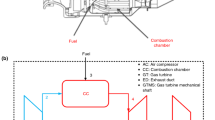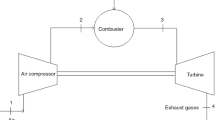Abstract
In this study, the kerosene fueled turboprop engine of a freight aircraft is investigated along with exergy dynamic, sustainability, and thermodynamic-based environmental and enviroeconomic analyses under 7 different flight phase points (starting from 1 to ending at 7) and 5 different flight phases during a flight cycle which is assumed to be performed per one day. It is found that maximum (88.756%) and minimum (0.492%) exergetic improvement potential ratios are found in the flight phase point 3 for the burner and intermediate-pressure turbine, respectively. Minimum exergy destruction improvement ratio (5.6%) is calculated for the high-pressure turbine at the flight phase point 3, while maximum rate (33.1%) is expressed for the burner at the flight phase point 1. Maximum released carbon dioxide emissions are found as 0.04605 kgCO2 kN−1 s−1, while maximum specific fuel consumption is 14.596 g kN−1 s−1 at the cruise phase between flight phase points of 4–6. Maximum environmental parameter (18,418.66 kgCO2 day_cycle−1) and emitted carbon dioxide price (2136.56 € day_cycle−1) are found between the flight phase points of 4–6 (cruise flight phase), while corresponding minimum rates are determined as 73.08 kgCO2 day_cycle−1 and 8.48 € day_cycle−1 in the takeoff phase between flight phase points of 1–2, respectively.







Similar content being viewed by others
References
Alkaabi KA, Debbage KG. The geography of air freight: connections to U.S. metropolitan economies. J Transp Geogr. 2011;19(6):1517–29. https://doi.org/10.1016/j.jtrangeo.2011.04.004.
Goetz AR, Budd L. The geographies of air transport. Transport and mobility series. Farnham: Ashgate; 2014.
Lordan O, Sallan JM, Simo P, Gonzalez-Prieto D. Robustness of the air transport network. Transp Res Part E Logist Transp Rev. 2014;68:155–63. https://doi.org/10.1016/j.tre.2014.05.011.
Duval DT. Critical issues in air transport and tourism. Tour Geogr. 2013;15(3):494–510. https://doi.org/10.1080/14616688.2012.675581.
Greer F, Rakas J, Horvath A. Airports and environmental sustainability: a comprehensive review. Environ Res Lett. 2020;15(10):1–24. https://doi.org/10.1088/1748-9326/abb42a.
Herndon SC, Jayne JT, Lobo P, Onasch TB, Fleming G, Hagen DE, Whitefield PD, Miake-Lye RC. Commercial aircraft engine emissions characterization of in-use aircraft at Hartsfield-Jackson Atlanta International Airport. Environ Sci Technol. 2008;42(6):1877–83. https://doi.org/10.1021/es072029+.
Antoine NE, Kroo IM. Aircraft optimization for minimal environmental impact. J Aircr. 2004;41(4):790–7. https://doi.org/10.2514/1.71.
Turgut ET, Acikel G, Gaga EO, Calisir D, Odabasi M, Ari A, Artun G, Ilhan SO, Savaci U, Can E, Turan S. A comprehensive characterization of particulate matter, trace elements, and gaseous emissions of piston-engine aircraft. Environ Sci Technol. 2020;54(13):7818–35. https://doi.org/10.1021/acs.est.0c00815.
Masiol M, Harrison RM. Aircraft engine exhaust emissions and other airport-related contributions to ambient air pollution: a review. Atmos Environ. 2014;95:409–55. https://doi.org/10.1016/j.atmosenv.2014.05.070.
Barrett SRH, Britter RE, Waitz IA. Global mortality attributable to aircraft cruise emissions. Environ Sci Technol. 2010;44(19):7736–42. https://doi.org/10.1021/es101325r.
Ekici S. Investigating routes performance of flight profile generated based on the off-design point: elaboration of commercial aircraft-engine pairing. Energy. 2020;193(116804):1–17. https://doi.org/10.1016/j.energy.2019.116804.
Ekici S. Thermodynamic mapping of A321-200 in terms of performance parameters, sustainability indicators and thermo-ecological performance at various flight phases. Energy. 2020;202(117692):1–10. https://doi.org/10.1016/j.energy.2020.117692.
Sun M, Tian Y, Zhang Y, Nadeem M, Xu C. Environmental impact and external costs associated with hub-and-spoke network in air transport. Sustainability. 2021;13(2):1–21. https://doi.org/10.3390/su13020465.
Keivanpour S, Kadi DA. A sustainable approach to aircraft engine maintenance. IFAC-PapersOnLine. 2015;48(3):977–82. https://doi.org/10.1016/j.ifacol.2015.06.210.
Upham P, Thomas C, Gillingwater D, Raper D. Environmental capacity and airport operations: current issues and future prospects. J Air Transp Manag. 2003;9(3):145–51. https://doi.org/10.1016/S0969-6997(02)00078-9.
Moolchandani K, Agusdinata DB, Mane M, DeLaurentis D, Crossley W. Assessment of the effect of aircraft technological advancement on aviation environmental impacts. In: 51st AIAA aerospace sciences meeting including the new horizons forum and aerospace exposition. Grapevine: American Institute of Aeronautics and Astronautics; 2013.
Agarwal R. Recent advances in aircraft technology. InTech; 2012.
Brunelle-Yeung E, Masek T, Rojo JJ, Levy JI, Arunachalam S, Miller SM, Barret SRH, Kuhn SR, Waitz IA. Assessing the impact of aviation environmental policies on public health. Transp Policy. 2014;34:21–8. https://doi.org/10.1016/j.tranpol.2014.02.015.
Hansell AL, Blangiardo M, Fortunato L, Floud S, de Hoogh K, Fecht D, Ghosh RE, Laszlo HE, Pearson C, Beale L, Beevers S, Gulliver J, Best N, Richardson S, Elliott P. Aircraft noise and cardiovascular disease near Heathrow airport in London: small area study. BMJ (Clin Res Ed). 2013;347:f5432. https://doi.org/10.1136/bmj.f5432.
Wing SE, Larson TV, Hudda N, Boonyarattaphan S, Fruin S, Ritz B. Preterm birth among infants exposed to in utero ultrafine particles from aircraft emissions. Environ Health Perspect. 2020;128(4):47002. https://doi.org/10.1289/EHP5732.
Yim SHL, Lee GL, Lee IH, Allroggen F, Ashok A, Caiazzo F, Eastham SD, Malina R, Barrett SRH. Global, regional and local health impacts of civil aviation emissions. Environ Res Lett. 2015;10(3):1–12. https://doi.org/10.1088/1748-9326/10/3/034001.
Dobson AP. Globalization and regional integration. The origins, development and impact of the single European aviation market. Routledge studies in the modern world economy, vol. 68. London: Routledge/Taylor & Francis Group; 2014.
Button K, Taylor S. International air transportation and economic development. J Air Transp Manag. 2000;6(4):209–22. https://doi.org/10.1016/S0969-6997(00)00015-6.
Cowper-Smith A, de Grosbois D. The adoption of corporate social responsibility practices in the airline industry. J Sustain Tour. 2011;19(1):59–77. https://doi.org/10.1080/09669582.2010.498918.
Cengel YA, Boles MA. Thermodynamics. An engineering approach. McGraw-Hill series in mechanical engineering. 6th ed. Boston: McGraw-Hill Higher Education; 2007.
Walsh PP, Fletcher P. Gas turbine performance. 2nd ed. Malden: Blackwell Science; 2008.
Ekici S, Yalin G, Altuntas O, Karakoc TH. Calculation of HC, CO and NOx from civil aviation in Turkey in 2012. Int J Environ Pollut. 2013;53(3/4):232–44. https://doi.org/10.1504/IJEP.2013.059919.
Caliskan H. Energy, exergy, thermoeconomic and sustainability analyses of a building heating system with a combi-boiler. Int J Exergy. 2014;14(2):244–73. https://doi.org/10.1504/IJEX.2014.060282.
Caliskan H. Energy, exergy, environmental, enviroeconomic, exergoenvironmental (EXEN) and exergoenviroeconomic (EXENEC) analyses of solar collectors. Renew Sustain Energy Rev. 2017;69:488–92. https://doi.org/10.1016/j.rser.2016.11.203.
Ekici S, Altuntas O, Acikkalp E, Sogut MZ, Karakoc TH. Assessment of thermodynamic performance and exergetic sustainability of turboprop engine using mixture of kerosene and methanol. Int J Exergy. 2016;19(3):295–314. https://doi.org/10.1504/IJEX.2016.075666.
Caliskan H, Mori K. Environmental, enviroeconomic and enhanced thermodynamic analyses of a diesel engine with diesel oxidation catalyst (DOC) and diesel particulate filter (DPF) after treatment systems. Energy. 2017;128:128–44. https://doi.org/10.1016/j.energy.2017.04.014.
Caglayan H, Caliskan H. Energy, exergy and sustainability assessments of a cogeneration system for ceramic industry. Appl Therm Eng. 2018;136:504–15. https://doi.org/10.1016/j.applthermaleng.2018.02.064.
Garbett NC, Chaires JB. Thermodynamic studies for drug design and screening. Expert Opin Drug Discov. 2012;7(4):299–314. https://doi.org/10.1517/17460441.2012.666235.
Hammond GP. Industrial energy analysis, thermodynamics and sustainability. Appl Energy. 2007;84(7–8):675–700. https://doi.org/10.1016/j.apenergy.2007.01.002.
Yildiz I, Caliskan H, Mori K. Energy, exergy and environmental assessments of biodiesel and diesel fuels for an internal combustion engine using silicon carbide particulate filter. J Therm Anal Calorim. 2021;145:739–50. https://doi.org/10.1007/s10973-020-10143-w.
Caglayan H, Caliskan H. Thermodynamic based economic and environmental analyses of an industrial cogeneration system. Appl Therm Eng. 2019;158(113792):1–9. https://doi.org/10.1016/j.applthermaleng.2019.113792.
Sohret Y, Ekici S, Altuntas O, Hepbasli A, Karakoc TH. Exergy as a useful tool for the performance assessment of aircraft gas turbine engines: a key review. Prog Aerosp Sci. 2016;83:57–69. https://doi.org/10.1016/j.paerosci.2016.03.001.
Dinc A, Sohret Y, Ekici S. Exergy analysis of a three-spool turboprop engine during the flight of a cargo aircraft. Aircr Eng Aerosp Technol. 2020;92(10):1495–503.
Aygun H, Kirmizi M, Turan O. Propeller effects on energy, exergy and sustainability parameters of a small turboprop engine. Energy. 2022;249(123759):1–12.
Balli O, Caliskan H. On-design and off-design operation performance assessments of an aero turboprop engine used on Unmanned Aerial Vehicles (UAVs) in terms of aviation, thermodynamic, environmental and sustainability perspectives. Energy Convers Manag. 2021;243(114403):1–13. https://doi.org/10.1016/j.enconman.2021.114403.
Aygun H. Thermodynamic, environmental and sustainability calculations of a conceptual turboshaft engine under several power settings. Energy. 2022;245(123251):1–11.
Balli O, Aygun H, Turan O. Enhanced dynamic exergy analysis of a micro-jet (μ-jet) engine at various modes. Energy. 2022;239(A):1–22.
Aygun H, Turan O. Environmental impact of an aircraft engine with exergo-life cycle assessment on dynamic flight. J Clean Prod. 2021;279(123729):1–14.
Balli O, Caliskan H. Energy, exergy, environmental and sustainability assessments of jet and hydrogen fueled military turbojet engine. Int J Hydrog Energy. 2022. https://doi.org/10.1016/j.ijhydene.2022.04.180.
Akdeniz HY, Balli O, Caliskan H. Energy, exergy, economic, environmental, energy based economic, exergoeconomic and enviroeconomic (7E) analyses of a jet fueled turbofan type of aircraft engine. Fuel. 2022;322(124165):1–22. https://doi.org/10.1016/j.fuel.2022.124165.
Sohret Y, Caliskan H. Thermodynamic-based analyses and assessments of a new-generation turbojet engine used for unmanned aerial vehicles (UAVs). J Therm Anal Calorim. 2022. https://doi.org/10.1007/s10973-022-11330-7.
Aygun H, Caliskan H. Environmental and enviroeconomic analyses of two different turbofan engine families considering landing and take-off (LTO) cycle and global warming potential (GWP) approach. Energy Convers Manag. 2021;248(114797):1–12. https://doi.org/10.1016/j.enconman.2021.114797.
Balli O, Caliskan H. Turbofan engine performances from aviation, thermodynamic and environmental perspectives. Energy. 2021;232(121031):1–14. https://doi.org/10.1016/j.energy.2021.121031.
Sohret Y, Ekici S, Karakoc TH. Using exergy for performance evaluation of a conceptual ramjet engine burning hydrogen fuel. Int J Hydrog Energy. 2018;43(23):10842–7. https://doi.org/10.1016/j.ijhydene.2017.12.060.
Ekici S, Sohret Y, Coban K, Altuntas O, Karakoc TH. Performance evaluation of an experimental turbojet engine. Int J Turbo Jet-Engines. 2017. https://doi.org/10.1515/tjj-2016-0016.
Ekici S, Sohret Y, Coban K, Altuntas O, Karakoc TH. Sustainability metrics of a small scale turbojet engine. Int J Turbo Jet-Engines. 2018;35(2):113–9. https://doi.org/10.1515/tjj-2016-0036.
EASA. Type-certificate data sheet for airbus A400M; 2013.
EASA. Type-certificate data sheet for TP400-D6 engine; 2021.
Meiriño AA. OCCAR pocket guide 2018; 2018.
Airbus. The pocket guide to A400M. The versatile airlifter; 2008.
Raymer D. Aircraft design: a conceptual approach. 6th ed. Washington: American Institute of Aeronautics and Astronautics, Inc; 2018. https://doi.org/10.2514/4.104909.
Walsh PP, Fletcher P. Gas turbine performance. 2nd ed. Hoboken: Blackwell Science; 2004.
Aydin H. Exergetic sustainability analysis of LM6000 gas turbine power plant with steam cycle. Energy. 2013;57:766–74.
Turgut ET, Karakoc TH, Hepbasli A, Rosen MA. Exergy analysis of a turbofan aircraft engine. Int J Exergy. 2009;6(2):181–99.
Aydin H, Turan O, Karakoc TH, Midilli A. Component–based exergetic measures of an experimental turboprop/turboshaft engine for propeller aircrafts and helicopters. Int J Exergy. 2012;11(3):322–48.
Aydin H, Turan O, Karakoc TH, Midilli A. Exergetic sustainability indicators as a tool in commercial aircraft: a case study for a turbofan engine. Int J Green Energy. 2015;12(1):28–40.
Turan O, Aydın H. Numerical calculation of energy and exergy flows of a turboshaft engine for power generation and helicopter applications. Energy. 2016;115:914–23.
Balli O, Aras H, Aras N, Hepbasli A. Exergetic and exergoeconomic analysis of an Aircraft Jet Engine (AJE). Int J Exergy. 2008;5(5):567–81.
Balli O. Exergy modeling for evaluating sustainability level of a high by-pass turbofan engine used on commercial aircrafts. Appl Therm Eng. 2017;123:138–55.
Tuzcu H, Sohret Y, Caliskan H. Energy, environment and enviroeconomic analyses and assessments of the turbofan engine used in aviation industry. Environ Prog Sustain Energy. 2021;40(3):1–8.
Caliskan H. Novel approaches to exergy and economy based enhanced environmental analyses for energy systems. Energy Convers Manag. 2015;89:156–61.
Kim BY, Fleming G, Balasubramanian S, Malwitz A, Lee J, Waitz I, Klima K, Locke M, Holsclaw C, Morales A, McQueen E, Gillette W. System for assessing Aviation’s Global Emissions (SAGE), version 1.5. Global aviation emissions inventories for 2000 through 2004. Federal Aviation Administration, Office of Environment and Energy; 2005. Available from: https://www.faa.gov/about/office_org/headquarters_offices/apl/research/models/sage/media/FAA-EE-2005-02__SAGE-Inventory_Report-Text.pdf. Access: 01 March 2021.
Air Traffic. Emission inventory guidebook—activities 080501–080504. December 2001 B851. Available from: https://www.eea.europa.eu/ds_resolveuid/1QP4SZ85H3. Access: 01 March 2021.
Turgut ET, Rosen MA. Assessment of emissions at busy airports. Int J Energy Res. 2010;34:800–14. https://doi.org/10.1002/er.1601.
Ecocostsvalue. The eco-costs of energy. TU Delft-Delfth University of Technology. https://www.ecocostsvalue.com/eco-costs/eco-costs-energy/#av_section_2 . Access: 01 March 2021.
Author information
Authors and Affiliations
Corresponding author
Additional information
Publisher's Note
Springer Nature remains neutral with regard to jurisdictional claims in published maps and institutional affiliations.
Rights and permissions
About this article
Cite this article
Dinc, A., Caliskan, H., Ekici, S. et al. Thermodynamic-based environmental and enviroeconomic assessments of a turboprop engine used for freight aircrafts under different flight phases. J Therm Anal Calorim 147, 12693–12707 (2022). https://doi.org/10.1007/s10973-022-11486-2
Received:
Accepted:
Published:
Issue Date:
DOI: https://doi.org/10.1007/s10973-022-11486-2




